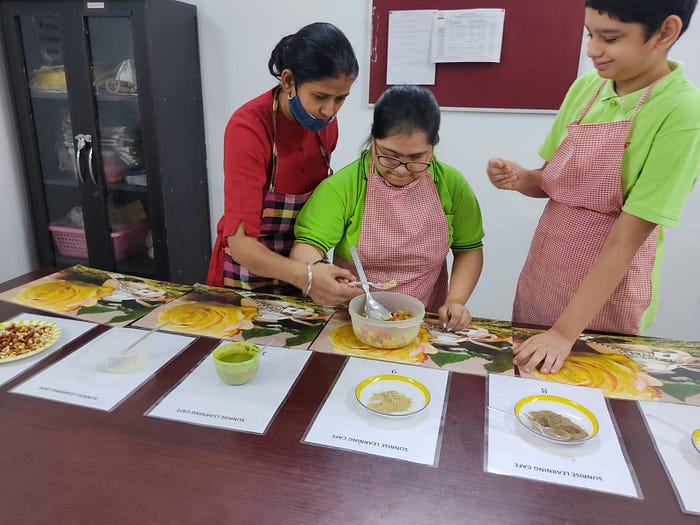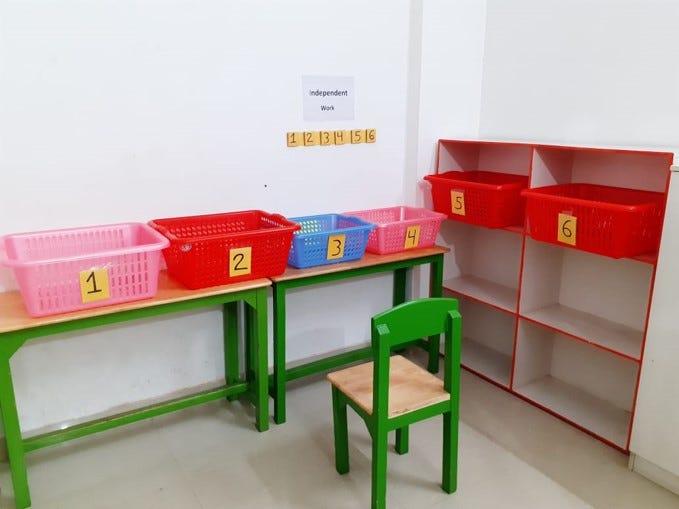Dr Sonali Kataria, Center-Head (SUNRISE LEARNING)
MBBS, MD (AIIMS), DNB, MNAMS, AUTISM SPECIALIST (IBCCES), EDUCATION ADMINISTRATION (SYMBIOSIS), SON-RISE PROGRAM (USA), TEACHERS TRAINING FOR AUTISM (ATI)
Blog compiled by Ms Anvi Mahajan
Being able to work independently, without being helped, is a commendable achievement and a victory for children & adults on the spectrum.
Teaching this skill is highly important because:
- While the child is independently and meaningfully engaged in an activity, the parents can carve out some valuable me-time for themselves.
- It gives the child an enhanced sense of confidence and happiness if he/she can perform an activity without any help, prompting or nagging.
It is never too early to start teaching your children skills that drive them towards independence. These skills don’t develop overnight, making it essential to start working towards this goal as early as possible. It may take a couple of years for the child to be able to perform an activity independently. From activity-based skills, we progress to life skills, then work-related skills and so forth. Hence, it is important to teach the child independent skills at all levels and capacities.
Secondly, consistency and patience are key. It is a helpful mindset to expect less and do more.
The cornerstone of SKILL TRAINING and of inculcating independent skills is to devise a structured work system. STRUCTURE of physical space, of time (schedule) and of activities (visual work system), is the KEY for skill training towards independence. It minimizes confusion, scope for errors, and reduces anxiety. This gives the child clarity about what the task is, how many steps does it include, when & where will it be performed, how to do it, and when can we consider it to be completed or “finished” etc. Examples of creating structures at home for time & activities – Writing the day’s schedule on a whiteboard, using a picture/ object/ text velcro visual schedule, a visual schedule folder or even a simple diary or register to enlist the tasks date-wise and stepwise.

Giving the child clarity about what tasks are to be performed is imperative. We should begin with the simplest tasks which may be easily performed with minimal or no prompts. One must remember to not give any verbal prompts or instructions while teaching independent skills. Only physical prompts may be used. Ideally, these should be prompted somewhere from behind where the shadow is not visible, functioning as an invisible force. To encourage independent work, these physical prompts should also fade away over time. For example, if you are bringing a nicely learnt (mastered) task into “independence” eg, asking your child to wash 2 plates, and you have laid down all the material that is needed with steps from LEFT to RIGHT, in a sequence structure, and if the hand-on-hand prompt is being used, to keep it errorless, the prompter’s hand can gradually move from the hands to the wrists, then to the elbows, then to the shoulders. Progressively, the prompter may just be passively present behind the child and subsequently move further away from the child as he/she performs the task.
The complexity and duration of the task should be increased over time.
Example- If your child is “scribbling inside a shape” with mastery, and if you put that task into “independent work” now, you can begin with 30 seconds of independent work (or one shape) and very gradually go up to a minute, 10 minutes (one worksheet with 4 shapes to color), 30 minutes (2–3 worksheets with coloring, tracing, matching activities that the child has already mastered) and ultimately, to however long the child can manage.
Over time, you may remain in the same space as your child as he/she does his/her activity independently while you do your work. This will help the child accept that you can simply be present and engaged in your work as he/she performs a task. Subsequently, you can also introduce another member to be present (other than yourself or the routine teacher) so that the child does not depend on one figure and learns to accept this change as well. This is called “generalization”, another crucial skill for the children on the autism spectrum to learn. For example- Ask another family member or teacher to be present in the room.
Ideally, we do not necessarily reinforce or reward the independent work as we want our child to imbibe these skills regardless of the reward. However, one can give the child another short, favourite activity to perform, as soon as the independent work is completed. Immediately after that, you can reward and reinforce that activity. This creates a pleasing sequence of activities, giving a boost in happiness, self-esteem and confidence while also giving the pleasure of doing a much-enjoyed activity following an independently performed task.
If the child leaves the activity midway, one should redirect the child gently, reminding him/her of the remaining steps in the schedule, encouraging them to return to the task. For some children, who quit the task frequently, concrete and visual cues may be more helpful. Visual cards which remind the child to continue working can be efficient visual-tactile reminders to return to the task without the facilitator’s intervention.
Small movement breaks (taking a walk, a little stretch), water or washroom breaks should be accommodated as the end goal is to ensure that the child enjoys performing independent tasks.
Gradually, we move on to prolonged tasks with increasing complexity while the presence of the parent/teacher starts fading (or is replaced by a new member).

What kind of activities can be taught to do independently?
Although the aim is to teach the child to do every activity independently, one should begin with activities that the child enjoys and can do. Initially, one should start with activity-based tasks (like puzzles, matching colours/alphabets, sorting chana and rajma beans, colouring and other short and easy activities). The workstation can be organized in a manner where there is an ‘unfinished task basket’ on left side and a ‘finished task basket’ on the right side. The child can keep picking materials from one basket and deposit them in the other as he/she finishes the activity. Gradually, we can move on to academic worksheets and life skills (for generalization of the skills & concepts that are learnt on the table- eg sorting vegetables & putting them in fridge, sorting washed utensils and keeping them in kitchen shelves & drawers).
These skills need to be taught to the child, step by step, starting with task analysis, shaping and chaining. Many activities of daily living are also best taught through reverse chaining, the last step being done first, it gives instant gratification & a sense of accomplishment, to further motivate the child to learn. The aim is to teach the task in the simplest form and gradually and progressively increase the task’s complexity.
Once a skill is learnt and the child has acquired fluency in it, we should bring the skill to practice and keep it in the maintenance phase. For example- While teaching a new skill, learnt skills should be alternated in the activity schedule. A difficult task can be alternated with an easier one or a new skill alternated with a learnt one.
Once the child has gained mastery in a skill, it can be introduced as independent work. This model may be used to teach life skills like making tea etc.

Some crucial factors to keep in mind to introduce independent work:
- Fading prompts over time (PROMPTS are extremely important to teach skills errorlessly and smoothly, but prompt dependence can become a tricky challenge, if they are not faded at the right time !)
- Gradually, Increasing distance and intervention of the parent/teacher/facilitator (to make “work” more and more “independent”).
- Progressively and gradually increasing task duration and complexity (to make “independent work” more and more functional and inculcate & generalize independence into life skills !!).

If you are new to the world of Autism, we would suggest you to read our article WELCOME TO AUTISM-LAND.
Or Do Read this blog which has amazing insights on MANAGING MELTDOWN IN CHILDREN WITH AUTISM.
Thank you for Reading. Please share this article to someone in your contact who needs to get some information on this.
Sharing is helping !!
If you want to subscribe to stay updated with our latest blogs. Fill in the form below.
[mc4wp_form id=”4687″]

